
The Stone Age of southern Tanzania

East Africa has always been important for the study of human evolution. It has the longest record of fossil hominids, extending back almost 5 million years. It also has a number of sites which show that the archaeological or cultural record goes back to 2.6 million years ago.
Mitochondrial Eve and the Middle Stone Age
But in the last two decades, it became clear that East Africa, and Africa in general, is as important for the later stages of human evolution as it is for the earlier ones. Genetic and fossil evidence show that our own species, Homo sapiens, evolved in Africa, as early as 200,000 years ago. Then around 50-40,000 years ago, descendants of this founder population spread out, replacing (or possibly interbreeding with) hominid groups in Eurasia such as the neandertals, and ultimately peopled the globe.
This out of Africa or mitochondrial Eve model means that modern humans were present during the Middle Stone Age or MSA in Africa (which dates between 200,000 and 30,000 years ago). In the last ten years, this has been confirmed by dating techniques such as uranium series, electron spin resonance and thermoluminescence of burned flint tools, which allow us to get chronometric ages for sites beyond the radiocarbon limit of the last 40,000 years. Before this, we thought that modern humans appeared when the Upper Palaeolithic began, around 40,000 years ago. Upper Palaeolithic sites show more complex technology in stone, bone, ivory and antler, as well as portable and eventually parietal (cave) art.
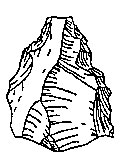

 MSA
points/convergent scrapers and crescent (from Richard Klein's The Human Career.
University of Chicago Press, 2nd edition, 1999).
MSA
points/convergent scrapers and crescent (from Richard Klein's The Human Career.
University of Chicago Press, 2nd edition, 1999).
![]()
 LSA
scraper and crescent (from Richard Klein's The Human Career. University
of Chicago Press, 2nd edition, 1999).
LSA
scraper and crescent (from Richard Klein's The Human Career. University
of Chicago Press, 2nd edition, 1999).
African MSA artifacts look very similar to those of neandertals in Europe (which belong to the Middle Palaeolithic), and show no obvious signs of complexity in an Upper Palaeolithic sense. Many archaeologists therefore assume that people only became behaviourally modern around 40,000 years ago, with the beginning of the LSA or Upper Palaeolithic. The reason is not clear. Some, like Richard Klein of Stanford University, suggest that true language and symbolic behaviour only became possible at this time, due to some neural reorganization. But others suggest that MSA/Middle Palaeolithic Africans were just as modern in their behaviour as LSA/Upper Palaeolithic ones.
 Richard Klein (in centre facing the camera) and Jerry Lowenstein, a molecular
biologist (right) at Duinefontein, Klein's Acheulean site near Cape Town, South
Africa in 1998.
Richard Klein (in centre facing the camera) and Jerry Lowenstein, a molecular
biologist (right) at Duinefontein, Klein's Acheulean site near Cape Town, South
Africa in 1998.
Dr. Richard Klein, Dr. Ariane Burke (who studies Middle Palaeolithic fauna in the Crimea) and Pamela Willoughby discussed the issue of when did anatomically modern humans become culturally modern on the Canadian Broadcasting Corporation's (CBC) national science show, Quirks and Quarks on April 13, 2002. Click here to go to the online version of this discussion.
Few sites which span the MSA to LSA transition are known from anywhere in Africa. So the tempo and mode of change between the two is not known. Even the places with remarkable records of the MSA, such as Klasies River in the coastal areas of South Africa, have little evidence of the transition, as it looks like the site was abandoned around 50,000 years ago. Others, such as Blombos Cave, are only reoccupied around 2,000 years ago.
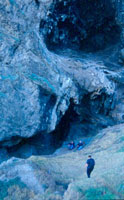
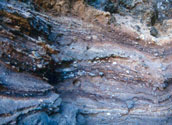
(a) Klasies River in 1998. (b) close up of level with hearths, shells and artifacts.
My field research in Tanzania
Pamela Willoughby's research in southern Tanzania addresses the question of MSA and LSA technological variability, its behavioural correlates, and the nature of the transition between the two. Working in the Western or Albertine Rift Valley, I have located and sampled numerous stone age sites, as well as excavating a few. Stone Artifacts are sorted by type, classified and measured. The resulting patterns may help understand MSA and LSA adaptations in this part of East Africa.
I first went to Tanzania in 1982 to look at core tools from the earliest archaeological sites at the National Museum of Tanzania in Dar es Salaam, belonging to the Oldowan and the early Acheulean, as part of my PhD research at UCLA.
I returned in 1988 to discuss setting up a long term field project in stone age archaeology with the local authorities (the Department of Antiquities who licence archaeological work, and COSTECH, the Tanzania Commission on Science and Technology, which issue research permits for any scientific work in the country). I travelled to Iringa to see Isimila, the Acheulean site, travelling through Mikumi National Park to get there. I agreed to initiate a project in a region which had not been the focus of much research in the past, the Rukwa rift valley in southwestern Tanzania (see location on map).
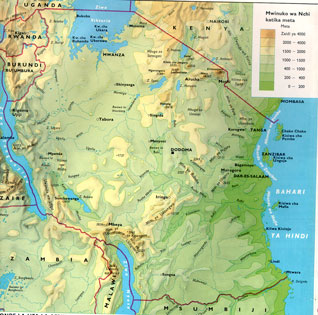
|
1989. In 1989, I travelled to Mbeya and Rukwa regions in the Albertine Rift Valley or Great Lakes Region to assess their archaeological potential. I was accompanied by Benedikt Hallgrimsson, who had recently completed an honours degree in Anthropology, and by P.J. Mpangala, an Antiquities officer. Some collections were made, and a small test pit was excavated at the LSA rockskshelter of Milanzi. Chamoto Hill was rediscovered. Other sites were investigated including Mkamba and the Songwe River valley, which became the focus of later field seasons. This field season was funded by the L. S. B. Leakey Foundation.
1990. In 1990, I spent three months doing a surface survey along the Songwe River which flows into Lake Rukwa. I was accompanied by Greg Miller, my MA student, and by Julie Cormack, as well as by three members of the Department of Antiquities (O.S. Kileo, Eliwasa Maro and Peter Abwalo). Part of the time was spent in Galula village. Numerous MSA, LSA and Iron Age sites were recorded on river terraces, in the open and in rockshelters at Mapogoro, an area near the modern village of Njelenje. Surface samples were taken, and a couple of open air sites were test excavated. Click here to see a group of photographs of Songwe sites. This field season was funded by SSHRC, the Social Sciences and Humanities Research Council of Canada..
1995. Test excavations were carried out at IdIu17 and IdIu22, both at Mapogoro, and more sites were recorded elsewhere in the Songwe. I was accompanied by Digna Tillya from the Department of Antiquities. This season was supported by the Central Research Fund at the University of Alberta.
1997. With support from SSHRC, I conducted more test excavations at IdIu22, as well as geomorphological sampling at a number of Songwe terrace sites. Dr. Celina Campbell, a geomorphologist, and Peter Abwalo from the Department of Antiquities made up the field crew.
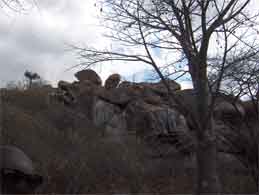 2005. Accompanied by Mr. Emmanuel Bwasiri of the Department of Antiquities, I returned to the Songwe for the month of June to
resume fieldwork on the Middle Stone Age in the Songwe. I excavated at IcIu18,
a rockshelter between Mapogoro and Mjele. I also investigated a number of rockshelters
in Iringa, with a view to test excavations in 2006. Support for this field season came from the HFASSR fund at the University of Alberta.
2005. Accompanied by Mr. Emmanuel Bwasiri of the Department of Antiquities, I returned to the Songwe for the month of June to
resume fieldwork on the Middle Stone Age in the Songwe. I excavated at IcIu18,
a rockshelter between Mapogoro and Mjele. I also investigated a number of rockshelters
in Iringa, with a view to test excavations in 2006. Support for this field season came from the HFASSR fund at the University of Alberta.
Magubike (above) and Mlambalasi (below).
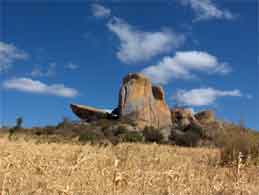 2006. Katie Biittner, Pastory Bushozi, Peter Abwalo (Antiquities Officer) and I excavated test pits at these two rockshelters. The first test pit at Magubike produced a sequence composed of the Iron Age, Later Stone Age, a MSA to LSA transitional layer, and then an extensive MSA deposit. In a second test pit under the main shelter, there is only the Iron Age and the same kind of MSA deposit, this time with fauna (animal bones and molluscs). At Mlambalasi, there appears to a continuous sequence of historic, Iron Age, a microlithic (Holocene) LSA, some human remains, then a macrolithic LSA (of Pleistocene age). There are MSA deposits outside of the main shelter, but most are covered by a major hunk of roof fall. So both sites can be used to test the process of transition from the Middle to the Later Stone Age. All of this material is still under analysis.Support for this field season came from the Killam Cornerstone Fund and the SAS Fund at the University of Alberta.
2006. Katie Biittner, Pastory Bushozi, Peter Abwalo (Antiquities Officer) and I excavated test pits at these two rockshelters. The first test pit at Magubike produced a sequence composed of the Iron Age, Later Stone Age, a MSA to LSA transitional layer, and then an extensive MSA deposit. In a second test pit under the main shelter, there is only the Iron Age and the same kind of MSA deposit, this time with fauna (animal bones and molluscs). At Mlambalasi, there appears to a continuous sequence of historic, Iron Age, a microlithic (Holocene) LSA, some human remains, then a macrolithic LSA (of Pleistocene age). There are MSA deposits outside of the main shelter, but most are covered by a major hunk of roof fall. So both sites can be used to test the process of transition from the Middle to the Later Stone Age. All of this material is still under analysis.Support for this field season came from the Killam Cornerstone Fund and the SAS Fund at the University of Alberta.
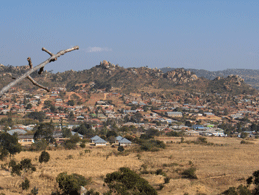 The city of Iringa, Tanzania.
The city of Iringa, Tanzania.
2008. I received a three-year SSHRC Standard Research Grant (for 2008 to 2011). We conducted an archaeological survey and a search for lithic raw material sources. We also returned to Magubike to determine the areal extent of this important MSA and LSA site.We uncovered a 2.5 metre thick deposit outside and below the main rockshelter at Magubike, which contains evidence of occupation in recent times, the Iron Age, LSA, a transitional level between the LSA and MSA, and then MSA. In addition to SSHRC, funding for the 2008 field season has come from the Wenner-Gren Foundation and from the Killam Cornerstone Fund at the University of Alberta. Participants in this field season were my four graduate students: Katie Biittner, Pastory Bushozi, Katharine Alexander and Benjamin Collins. Our Antiquities officer was Emmanuel Bwasiri.
In July and August, 2010, we excavated a 2 by 3 m trench at Mlamabalasi, to determine the extent of the human remains and their archaeological context. We uncovered a sequence ranging from recent history through the Iron Age and Later Stone Age (both Holocene and late Pleistocene). Participants in this field season were Katie Biittner, Pastory Bushozi, Frank Masele, Elizabeth Sawchuk, Jennifer Miller, and Saidi Kilindo from the Univeristy of Dar es Salaam. Our Antiquities officers were Anthony Tibaijuka and Emmanuel Katoroki.
In 2011, I received another 3-year SSHRC Standard Research Grant (for 2011 to 2014) which will allow members of what we have recently named the Iringa Region Archaeological Project to continue fieldwork in southern Tanzania. Official collaborators (=co-investigators) on this new grant are Dr. Katie Biittner, Dr. Pastory Bushozi (Department of History and Archaeology, University of Dar es Salaam, Tanzania), Dr. Anne Skinner (Williams College, Massachussetts, USA) and Dr. Christopher Stringer (Natural History Museum, London, United Kingdom).
In 2012, we excvated in the oldest MSA deposits in Magubike, and collected samples for OSL, ESR and radiocarbon dating. Twenty-one undergraduate archaeology students from the University of Dar es Salaam joined us under the supervision of Dr. Pastory Bushozi and Mr. Macarius Peter. Here are all of us showing off the "Sangoan" pick from test pit 11. I (Pam) am in the middle.
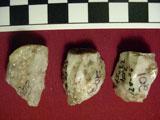 On
line news stories about this research
On
line news stories about this research
(Above - bladelet cores from a Songwe LSA site; scale is in centimetres)
The April 28, 2000 issue of Folio includes an article about this project titled "When did history begin?". (Folio is the University of Alberta's staff newspaper).
The CBC national science show Quirks and Quarks of April 13, 2002 featured a discussion between Richard Klein, Ariane Burke and Pamela Willoughby on when did anatomically modern humans become culturally modern.
We held an open house to showcase our finds from 2006. As a result, The Edmonton Sun reported on this research on September 18, 2007: "University scientists studies tools of early man".
The Gateway, the student newspaper at the University of Alberta, included an article on October 3, 2007. "Tools may dig up historical clues".
Click here to see an article announcing my 2011 SSHRC Standard Research Grant (which runs to 2014).
"Tracing humanity's African ancestry". New article about the Iringa Region Archaeological Project (IRAP) posted on University of Alberta News web site on December 13, 2012.
Return to top.
Return to my home page.